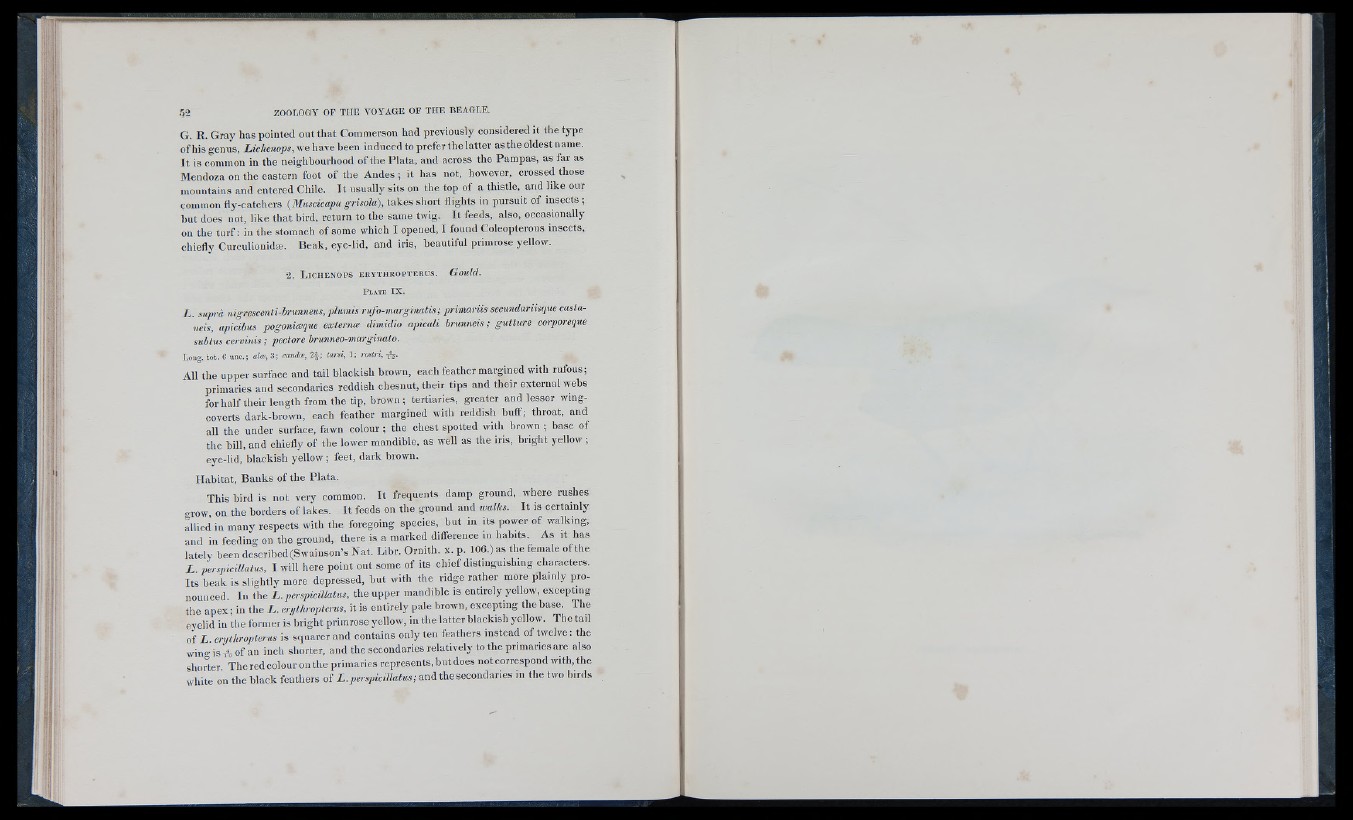
I
I'i
Ü. R. Gray has pointed out that Commerson had previously considered it the type
of his genus, Lichenops, v e have been induced to prefer the iatter as the oldest name.
It is common in the neighbourhood of the Plata, and across the Pampas, as far as
Mendoza on the eastern foot of the Andes ; it has not, however, crossed those
mountains and entered Chile. It nsually sits on the top of a thistle, and like onr
common fly-catchers {Jlnscicapa grisola), takes short flights in pursuit of insects ;
l)ut does not, like that bird, return to the same twig. It feeds, also, occasionally
on the turf: in tlie stomach of some which I opened, I found Coleopterous insects,
cliiefly Curculionidæ. Beak, eye-lid, and iris, beautiful primrose yellow.
2 . L i c h e n o p s e r y t h r o p t e r u s . Gould.
P la t e I X .
i . suprà uigrescenti-bninneus, plumis riifo-marginatis; primariis secundariisque casta-
neis, apicibus pogonioeque externoe dimidio apicali brunneis; gutture corporeque
subtus cervinis ; pectore brunneo-marginato.
Long. tot. C line.; aloe, 3; caudæ, 2 |; tarsi, 1; rostri,
All the upper surface and tail blackish brown, each feather margined with rufous;
primaries and secondaries reddish chesnut, their tips and their external webs
f o r h a l f their length from the tip, brown; tertiaries, greater and lesser wing-
coverts dark-brown, each feather margined with reddish buff; throat, and
all the under surface, fawn colour ; the chest spotted with brown ; base of
the bill, and chiefly of the lower mandible, as well as the iris, bright yellow ;
eye-lid. blackish yellow ; feet, dark brown.
Habitat, Banks of the Plata.
This bird is not very common. It frequents damp ground, where rushes
o row on the borders of lakes. It feeds on the ground and walks. It is certainly
¿Hied in many respects with the foregoing species, but in its power of walking,
and in feeding on the ground, there is a marked difference in habits. As it has
lately been described (Swainson’s Nat. Libr. Ornith. x. p. 106.) as the female of the
L perspicillatus, I will here point out some of its cliief distinguishing characters.
Its beak is slightly more depressed, but with the ridge rather more plainly pronounced
In the L. perspicillatus, the upper mandible is entirely yellow, excepting
the apex ■ in the L . erqlhroplerus, it is entirely pale brown, excepting the base. The
evelid ill the former is bright primrose yellow. In the latter blackish yellow. The tail
of L enjlhrapterus is squarer and contains only ten feathers instead of twelve : the
wing is A of an inch shorter, a n d the secondaries relatively to the primaries are also
shorter The red colour on the primaries represents, butdoes not correspond with, the
white on the black feathers o f and the secondaries in the two birds
■ I
lit